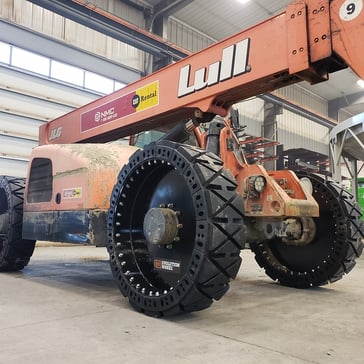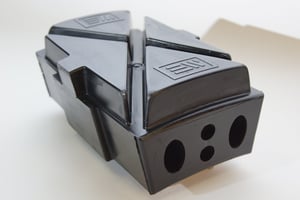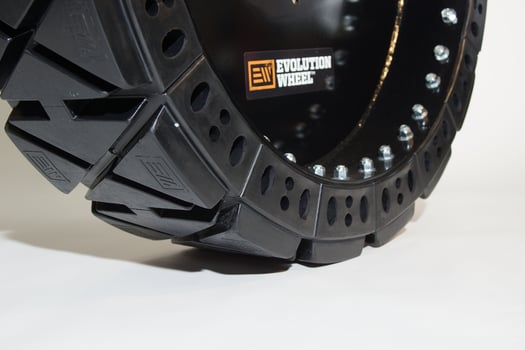
As a contractor, your biggest concern is avoiding flat tires on your telehandler. So, it makes sense to look for tire solutions that cannot get flat even when damaged. This gives us two main options: (1) Solid telehandler tires and (2) foam-filled telehandler tires. Both prevent flats, but there are still significant differences between them. Here are some important distinctions between the two:
Foam Filled Telehandler Tires
At first glance, foam-filled telehandler tires seem like a great solution to tire flats. Instead of air, they’re loaded with thick foam. The advantages of foam-filled telehandler tires are that the foam won't leak out through small holes, like those made by driving over nails. You will also typically see a significant reduction in flat tires. However, this comes with trade-offs and costs that you will likely find unacceptable over time if you run a machine long enough.
One of the biggest trade-offs is that foam-filled telehandler tires easily suffer sidewall damage like pneumatic tires. When the damage is severe enough, the foam will start squeezing out of the tire resulting in a hobbling tire and eventually a flat. This type of damage is common on construction sites and industrial areas. Once this happens, there’s no way to fix the tire. The entire tire must be replaced at substantial expense. Expenses come not only from the cost of replacing the tire but also from labor costs to replace the tire. Another costly expense also happens with the tire itself, as often the damaged tire still has quite a bit of usable tread depth remaining meaning that you rarely get full life or value out of a set of foam filled telehandler tires. This means that you pay twice as much for that one damaged tire. This is because you only used part of the tire's wear life.
Another unexpected cost associated with foam filled telehandler tire replacement is higher labor and service costs. That's because, unlike air-inflated tires, foam-filled telehandler tires typically have to be cut off the rim. This is a slow, tedious, and demanding process that significantly increases labor hours. Not to mention your telehandler is out of service while repaired.
Depending on what you'd normally use that equipment for, the delay could cost your company thousands in downtime. While foam filled telehandler tires are cheaper up front, they're significantly more expensive over the tire lifespan because of replacement, labor, and downtime costs.
Solid Telehandler Tires
Solid telehandler tires are made of a consistent rubber compound. This means there’s no air or foam leaking out of the tire no matter what type of damage the tire gets. They never flatten under any circumstances. But this has more benefits than preventing flats. They can handle cuts and chunking without compromising the tire integrity. And when it finally is time to replace them, the tire and rim can be replaced at the same time. Or a new tire can be pressed on, or if the tire has serviceable new segments, can be installed.
Other benefits of solid telehandler tires include traction, stability and extended wear life. Solid telehandler tires typically have taller, wider and deeper tread than pneumatic and foam-filled tires. This is because of the absence of a tire casing allows for greater design possibilities. Another benefit is increased stability compared to pneumatic tires and foam-filled telehandler tires. This is because when they lose air or foam, it causes excess bounce when the machine hits a bump. Solid telehandler tires don’t experience this excess bounce. Increased stability also occurs with solid telehandler tires because the rubber compresses at a consistent and predictable rate when loaded. This means operators will have more control over loads at extended reach.
Another advantage of solid telehandler tires over foam-filled telehandler tires is improved wear life. This is due to increased lug sizes and harder rubber compounds. In fact, the wear life of solid telehandler tires is estimated to be three times greater than foam-filled telehandler tires.
What Makes Evolution Wheel’s Solid Telehandler Tires Different?

Our segmented solid telehandler tires take these benefits even further. Since no tire is completely invincible, we make ours with easy servicing in mind. This saves you time and money when repairing a segment. Our design ensures that you will never have to replace the entire tire when damage occurs. Just repair it as needed.
Our tires are made up of separate segments instead of being pressed onto the rim as a single unit. Each segment is separate from the rest, so if one segment gets damaged, you only need to replace that one segment. Each individual segment bolts onto the rim, so the damaged segment can be fixed without removing the tire from the machine. This design saves you the cost of a new tire and service call. It also saves you money because your equipment is back to work within a few minutes.
It also means that you’re getting the FULL wear out of each tire as you’re only replacing the individual damaged segment rather than the whole tire. Our segmented solid telehandler tire also makes for quick and easy fixing as the machine operator can replace the damaged segment on their own with a simple tool such as a wrench.
To learn more about our segmented EWRS-TH Evolution Wheel solid telehandler tires, contact one of our Evolution Wheel product specialists and they can discuss your exact tire needs. We'll be glad to discuss with you our solid telehandler tires and other machine segmented solid tires options available.


